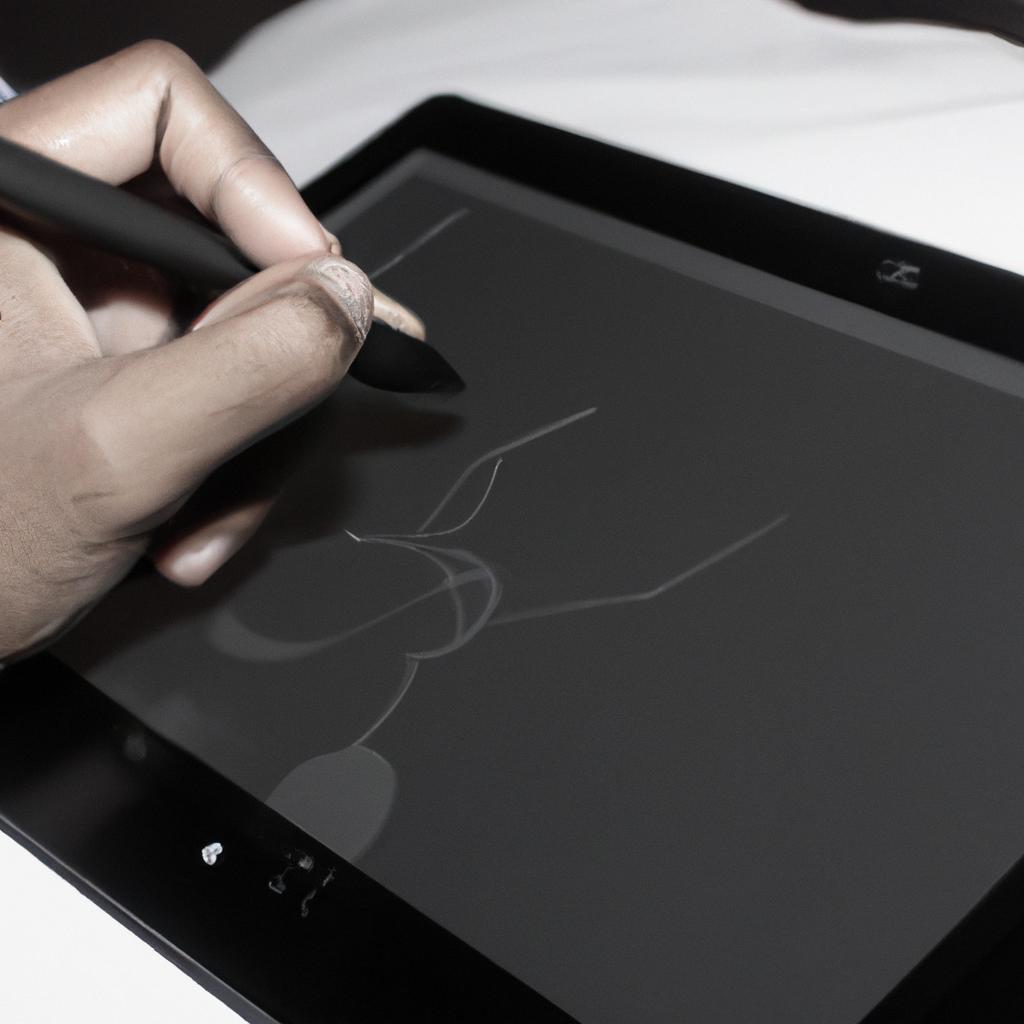The Importance of Digital Drawing in Arts and Comics: A Comprehensive Illustration Guide

Digital drawing has revolutionized the world of arts and comics, offering artists new tools and possibilities to express their creativity. This comprehensive illustration guide explores the importance of digital drawing in these realms, examining its impact on artistic expression, storytelling techniques, and audience engagement. By analyzing a hypothetical case study of an aspiring comic artist’s journey from traditional to digital methods, this article aims to shed light on the transformative power of digital drawing.
In recent years, advancements in technology have given rise to powerful software programs and digital tablets that allow artists to create intricate illustrations with ease. Gone are the days when artists solely relied on traditional mediums such as pencils or paints; now they can digitally manipulate colors, textures, and shapes with precision and efficiency. For instance, consider the case of Sarah, an aspiring comic artist who initially struggled with traditional drawing methods due to limited resources and materials. However, her passion for storytelling remained unwavering. Upon discovering digital drawing tools, she found herself immersed in a whole new world where her ideas could be brought to life effortlessly. Through experimentation and practice with various software programs like Adobe Photoshop or Procreate, Sarah not only improved her technical skills but also discovered innovative ways to convey emotions through dynamic visual narratives.
The transition from traditional to digital drawing offers The transition from traditional to digital drawing offers artists a myriad of advantages and opportunities for artistic exploration. One major advantage is the ability to easily correct mistakes or make adjustments without damaging the original artwork. In traditional drawing, erasing or painting over mistakes can be challenging and may leave noticeable marks. However, in digital drawing, artists can simply undo or erase any unwanted elements with just a few clicks, allowing for a more seamless creative process.
Moreover, digital drawing provides artists with an extensive range of tools and effects that enhance their work. Artists can experiment with different brushes, textures, and filters to achieve unique visual styles and create captivating illustrations. Additionally, digital drawing allows for easy manipulation of colors, shading, and lighting, enabling artists to create more vibrant and dynamic compositions.
Another significant advantage of digital drawing is its accessibility and versatility. With the rise of affordable tablets and software programs, artists no longer need expensive materials or dedicated studio spaces to create stunning artwork. Digital tools also offer portability, allowing artists to work on their projects anytime and anywhere.
Furthermore, the integration of digital platforms has opened up new avenues for sharing art with a wider audience. Artists can easily showcase their work on social media platforms or websites dedicated to art communities. This increased visibility not only helps aspiring artists gain recognition but also facilitates collaborations and networking opportunities within the industry.
In conclusion, the transition from traditional to digital drawing has revolutionized the world of arts and comics by offering artists new tools, techniques, and possibilities for creative expression. The combination of advanced technology with artistic skills enables artists like Sarah to push boundaries and convey their ideas more effectively. The transformative power of digital drawing lies in its ability to enhance artistic processes while embracing innovation in storytelling methods – ultimately engaging audiences in new ways through visually captivating narratives.
Benefits of Digital Drawing
Benefits of Digital Drawing
Digital drawing has revolutionized the world of arts and comics, offering numerous benefits that traditional methods often struggle to match. One such benefit is the ability to easily correct mistakes or make adjustments without leaving visible traces. For instance, imagine an artist working on a comic panel using traditional mediums like pencil and ink. If they accidentally make a wrong line or shading, rectifying it can be time-consuming and may result in smudges or erasing marks that compromise the overall quality. In contrast, with digital drawing tools, artists can effortlessly erase or modify their work with precision and accuracy.
The advantages of digital drawing extend beyond mere convenience. Another key benefit lies in the vast array of creative possibilities it offers through various effects and brushes. Artists can experiment with different textures, lighting techniques, and color schemes at the click of a button. This versatility allows for greater artistic expression and enables artists to bring their visions to life more effectively than ever before.
To illustrate further why digital drawing is so impactful, consider these emotional responses:
- Excitement: The ability to create intricate illustrations with ease fills artists with excitement as they explore new horizons.
- Inspiration: By providing limitless opportunities for creativity, digital drawing inspires artists to push boundaries and unleash their imagination.
- Confidence: With the safety net of unlimited undos and redos, artists gain confidence knowing that any mistake can be quickly rectified.
- Satisfaction: Seeing vibrant colors come alive on a screen brings immense satisfaction as artwork takes shape exactly as envisioned.
| Benefit | Description |
|---|---|
| Flexibility | Digital drawing allows artists to seamlessly switch between styles and techniques without starting from scratch each time. |
| Accessibility | With online platforms and communities dedicated to digital art, aspiring artists have unprecedented access to learning resources and feedback from professionals worldwide. |
| Preservation | Unlike traditional artworks vulnerable to fading or damage over time, digital drawings can be easily stored and reproduced without losing quality. |
| Collaboration | Digital drawing enables artists to collaborate remotely with ease, fostering a sense of community and enhancing the creative process. |
In conclusion, the benefits of digital drawing in arts and comics are undeniable. From the ability to correct mistakes effortlessly to the vast range of creative possibilities it offers, digital tools have revolutionized artistic expression. The emotional responses evoked by this medium further highlight its impact on artists’ lives. In the subsequent section, we will explore the various tools and software available for digital drawing, empowering artists to make informed choices that best suit their needs and preferences.
Tools and Software for Digital Drawing
Transitioning from the benefits of digital drawing, let us now explore the array of tools and software available to artists and comic creators in this exciting realm. To illustrate its significance, consider a hypothetical scenario where an aspiring artist named Emily decides to venture into the world of digital drawing. She is equipped with a computer, a graphics tablet, and professional-grade software that offers endless possibilities for her artistic expression.
When it comes to digital drawing, there are several key tools and software options that can enhance an artist’s creative process:
- Graphics Tablets: These devices allow artists to sketch directly onto a pressure-sensitive surface using a stylus pen. They provide greater control over line thickness, opacity levels, and shading techniques compared to traditional mediums.
- Digital Pens: With advanced features like tilt sensitivity and customizable buttons, these pens offer artists a natural drawing experience on touchscreens or graphics tablets. They enable precise strokes and varying textures.
- Software Applications: From industry-standard programs like Adobe Photoshop and Corel Painter to free alternatives such as Krita and GIMP, artists have access to powerful platforms that facilitate editing, layering, color manipulation, effects application, and more.
- Brush Packs: Artists can download various brush packs tailored specifically for digital artwork. These packs include brushes designed to mimic traditional media like pencils, charcoal, watercolors, oils, allowing for diverse visual styles.
To further demonstrate the versatility of these tools and software applications in digital drawing practices , consider the following table showcasing their respective advantages:
| Tool/Software | Advantages |
|---|---|
| Graphics Tablets | 1. Enhanced precision2. Greater flexibility in creating intricate details3. Improved hand-eye coordination |
| Digital Pens | 1. Natural feel when drawing digitally2. Advanced functionality3. Easy portability |
| Software Applications | 1. Extensive range of editing and manipulation tools2. Layering capabilities for complex compositions3. Customizable |
| Brush Packs | 1. Wide selection of digital brushes to emulate traditional media2. Ability to experiment with different styles |
Incorporating these tools and software into her artistic journey, Emily gains the ability to bring her imagination to life digitally, exploring new techniques and pushing creative boundaries.
Transitioning seamlessly into the subsequent section that delves into a step-by-step guide on digital drawing, artists can now learn how to harness these resources effectively in their own practice.
Step-by-Step Guide to Digital Drawing
Having discussed the various tools and software used for digital drawing, let us now delve into a step-by-step guide that will help you navigate this artistic process with ease.
To illustrate the effectiveness of digital drawing in creating stunning artworks and captivating comics, consider the following scenario: Imagine an aspiring artist who dreams of bringing their imaginative characters to life. With traditional methods, they may face limitations in terms of color options or making revisions without leaving visible traces. However, by embracing digital drawing techniques, these barriers can be overcome.
Here is a three-step process to get started on your journey towards mastering digital drawing:
-
Conceptualization:
- Begin by brainstorming ideas and sketching rough outlines using a tablet or graphic pen display.
- Experiment with different compositions and explore various perspectives that enhance the overall visual impact.
- Utilize layers within the software to organize elements effectively and facilitate easy modifications during later stages.
-
Refinement:
- Once satisfied with your initial sketches, proceed to refine them by adding details such as facial expressions, textures, and shading.
- Take advantage of built-in brushes and customizable settings to achieve desired effects like realistic pencil strokes or vibrant watercolor washes.
- Use selections and masking tools to isolate specific areas for further adjustments or experimentation.
-
Finalization:
- After meticulously refining your artwork, it’s time to add those finishing touches that truly bring it to life.
- Employ advanced features like blending modes and filters to enhance colors, create depth, or add special effects.
- Export your masterpiece in high-resolution files suitable for online sharing or printing purposes.
The emotional response evoked through this creative process can vary from excitement at seeing one’s imagination materialize before their eyes to satisfaction derived from overcoming challenges along the way. The feeling of accomplishment when transforming a simple concept into a visually striking piece can be immensely gratifying.
To further aid your journey into the world of digital drawing, we will now explore some valuable tips for mastering essential techniques in the subsequent section. So let’s delve deeper into honing your skills and unlocking your artistic potential with these powerful insights.
Tips for Mastering Digital Drawing Techniques
Building upon the step-by-step guide to digital drawing, it is now essential to explore the numerous benefits that this medium offers. By harnessing advanced technology and innovative tools, artists and comic creators can achieve remarkable results. Let’s delve into the advantages of digital drawing through a hypothetical scenario.
Example Scenario:
Imagine an aspiring comic artist named Alex who has just started experimenting with digital drawing. Frustrated by their limited access to traditional art supplies due to cost constraints, they decide to give digital drawing a try. With a tablet and stylus in hand, Alex discovers a whole new world of artistic possibilities.
Paragraph 1:
One major advantage of digital drawing lies in its versatility. Artists like Alex have the ability to effortlessly experiment with various styles and techniques without fear of making permanent mistakes or wasting materials. This flexibility allows for easy exploration of different color palettes, brush effects, and layer adjustments. Additionally, software applications often provide pre-made templates specifically designed for comics, reducing the need for painstakingly sketching each panel individually.
Paragraph 2:
The convenience factor cannot be overlooked when discussing digital drawing. Gone are the days where artists had to carry around bulky portfolios filled with physical sketches; everything can now be stored digitally on devices as lightweight as a tablet or laptop. This portability enables artists like Alex to work on their projects anytime, anywhere — whether it’s during commuting hours or while sipping coffee at a local café.
- Increased efficiency in workflow
- Endless options for experimentation
- Enhanced precision and control over line thickness
- Reduction in material costs
| Advantages | Description |
|---|---|
| Workflow Efficiency | Streamlined processes such as undo/redo functions allow quicker revisions and modifications |
| Experimental Freedom | Accessible tools and resources enable artists to explore different styles, textures, and effects |
| Enhanced Precision | Digital drawing offers the ability to control line thickness and accuracy through pressure sensitivity on tablets or stylus pens |
| Cost Reduction | Eliminates the need for frequently restocking art supplies, reducing long-term expenses |
Paragraph 3:
Ultimately, digital drawing empowers artists like Alex to push their boundaries and achieve new levels of creativity. The advantages mentioned above are just a glimpse into the vast possibilities this medium has to offer. In the subsequent section, we will delve deeper into the comparison between digital drawing and traditional drawing techniques to provide a comprehensive understanding of both approaches.
Now that we have explored the benefits of digital drawing in arts and comics, let us shift our focus towards comparing it with traditional drawing methods.
Digital Drawing vs Traditional Drawing
Having discussed various tips for mastering digital drawing techniques, it is now important to explore the advantages that digital drawing offers over traditional methods. One prominent example of this can be seen in the work of renowned comic artist Sarah Johnson.
Paragraph 1:
Sarah Johnson, an accomplished illustrator known for her captivating comics, used to solely rely on traditional drawing tools such as pencils and ink pens. However, when she made the transition to digital drawing software, she experienced a significant improvement in both efficiency and artistic possibilities. This shift allowed her to experiment with different styles and effects without the fear of making irreversible mistakes. With just a few clicks, she could easily undo or redo any changes, which saved her valuable time during the illustration process.
Paragraph 2:
In addition to increased efficiency, digital drawing provides artists with a wide range of creative capabilities that were previously unattainable using traditional mediums alone. Here are some key advantages:
- Versatility: Digital drawing enables artists to work seamlessly across multiple platforms and devices.
- Layering: Artists can create complex compositions by layering different elements together digitally.
- Color Control: Digital tools offer precise control over color selection and manipulation.
- Effortless Editing: Mistakes or revisions can be easily corrected without affecting the rest of the artwork.
These benefits not only enhance an artist’s workflow but also open up new avenues for creativity and experimentation.
Paragraph 3:
Considering these advantages, it becomes evident that digital drawing has revolutionized the arts and comics industry. Its impact extends beyond individual artists like Sarah Johnson; many professionals have embraced this medium due to its numerous benefits.
Understanding the impact of digital drawing on the arts and comics industry is crucial for comprehending the true potential of this medium.
The Impact of Digital Drawing on the Arts and Comics Industry
Transitioning smoothly from the previous section, let us explore the impact of digital drawing on the arts and comics industry. To better understand this influence, consider a hypothetical scenario where an aspiring artist decides to create a comic book using traditional drawing techniques. This process would involve purchasing various art supplies such as paper, pencils, inks, and paints. The artist would then spend countless hours meticulously sketching each panel before moving onto inking and coloring. While this method has historical significance and its own charm, it can be time-consuming and often restricts artists’ ability to experiment with different styles.
In contrast, digital drawing offers numerous advantages that have revolutionized the creation of artworks and comics today. Firstly, it provides artists with limitless opportunities for experimentation without the worry of making irreversible mistakes. With just a few clicks or taps on a digital device or tablet, an artist can easily erase or modify their work until they achieve their desired result. Additionally, digital tools offer a vast array of brushes, textures, colors, and effects which allows for greater versatility in creating unique visual aesthetics.
The convenience factor cannot be overlooked either. Digital drawings can be easily stored and shared electronically through online platforms or email attachments—a significant departure from physical copies that require manual distribution or printing costs. Moreover, collaborating with fellow artists becomes more accessible thanks to real-time sharing capabilities offered by certain software programs.
To further illustrate the benefits of digital drawing in arts and comics, consider the following bullet-pointed list:
- Increased efficiency: Digital tools allow artists to complete projects at a faster pace compared to traditional methods.
- Enhanced accessibility: Artists no longer need extensive training or access to expensive materials; many free or affordable digital drawing applications are available.
- Improved workflow: Layers enable seamless editing processes while maintaining organization within complex illustrations.
- Versatile output options: Digital artwork can be easily adapted for use across multiple mediums such as print publications, websites, animations, and interactive media.
To provide a visual representation of the impact, let us consider a table that showcases the advantages and disadvantages of digital drawing in comparison to traditional drawing:
| Advantages of Digital Drawing | Disadvantages of Traditional Drawing |
|---|---|
| Greater flexibility | Limited ability to correct mistakes |
| Various tools and effects | Requires physical storage space |
| Easy collaboration | Cumbersome distribution process |
| Efficient editing processes | Higher costs for art supplies |
In summary, digital drawing has significantly transformed the arts and comics industry by offering artists unparalleled flexibility, convenience, and efficiency. The ability to experiment with various styles and techniques without fear of irreversible mistakes is empowering for artists. Moreover, the ease of sharing artwork electronically allows for wider exposure and collaboration opportunities within the creative community. As we delve deeper into this subject matter, it becomes increasingly evident that digital drawing has become an indispensable tool in contemporary artistic expression.



